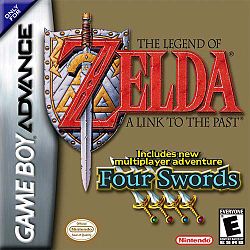Pre-release
Nintendo World Report's Max Lake called the announcement of a multiplayer mode "exciting". [12] In IGN 's Best of E3 awards for the Game Boy Advance, they named it the runner-up to Best of Show below Metroid Fusion , calling it a "close one", but ultimately gave the award to Fusion due to it not being a remake. They described the multiplayer component as resembling Diablo or Gauntlet . They gave it the award for Biggest Surprise, citing its multiplayer mode, calling it a "brilliant addition" and "well worth the price of four Legend of Zelda cartridges". [20] IGN's Craig Harris, in his preview of the game, called the port of A Link to the Past "faithful". Although he noted that the controls would have to be modified due to the GBA's lack of two buttons that were both used in the Super NES version, he found the new controls to be adequate and praised the visuals for holding up well. [21] IGN reported that based on their then new wishlist tool, A Link to the Past & Four Swords was consistently the second most anticipated Game Boy Advance game for the five weeks before its release. [22] [23] [24] [25] [26]
Post-release
Since its release, The Legend of Zelda: A Link to the Past & Four Swords has been met with highly positive reception. It holds an aggregate score of 91.70% and 95 at GameRankings and Metacritic respectively, indicating "universal acclaim". [27] [28] It is the highest rated Game Boy Advance game on the sites. The game was a top seller in Japan following its release. It was the second highest title in number of sales the week of its release, and was number six the following week with 0.04 million units. [33] It sold 1.63 million copies in North America as of December 2007, and 0.29 million in Japan as of December 2009. [34] [35] GamePro 's Star Dingo called it a "masterpiece", as well as an "important part of the Grand Renaissance of the Second Dimension". He praised the overworld for its secrets and "quirky random characters", adding that playing it required patience and exploring. [36] G4TV praised it for being good for anyone anticipating The Legend of Zelda: The Wind Waker . [28] IGN's Craig Harris praised the game, giving the gameplay and lasting appeal perfect scores. They praised both modes' puzzle designs, calling the Super NES game the best 2D video game ever, while praising the replay value for offering unlockables to keep players playing. [8]
IGN included it in their Game Boy Advance Holiday Buyers Guide for 2002, calling its inclusion of multiplayer a "big deal" and that it was the most requested Super NES port for the Game Boy Advance. [37] IGN named it the third best Game Boy Advance game, praising the Game Boy Advance for handling the game so well, and citing the multiplayer component for making the game "truly awesome". [38] They included it on their list of most-wanted Nintendo DSi Virtual Console games, a hypothetical service that in IGN's view would offer handheld games similar to the Wii's Virtual Console. They once again praised the multiplayer mode, questioning why Nintendo has yet to make a follow-up game on the Nintendo DS or DSiWare. [39] Eurogamer 's Tom Bramwell praised it, commenting that the port held up over the years, calling it "amazingly deep" and a "gateway drug into the genre". In reviewing the multiplayer component, he commented that while it was not as good as A Link to the Past, it was still remarkable, but he found fault in the difficulty of finding three other players with Game Boy Advances and copies of the game to play it with. [40]
During the 6th Annual Interactive Achievement Awards, the Academy of Interactive Arts & Sciences nominated A Link to the Past and Four Swords for "Handheld Game of the Year". [41]
Audiovisuals
GamePro's Star Dingo praised the port of A Link to the Past's ability to retain its visuals. He specifically praised its "clean sprites", calling its overworld a "colorful, happy place", sarcastically calling it "kiddy". [36] Writing for IGN , Craig Harris praised Four Swords' visuals and further called The Legend of Zelda's overture "breathtaking", applauding the Game Boy Advance for recreating the graphics and audio for A Link to the Past from the original Super NES game. [8] He gave praise to the music of the multiplayer mode as well, calling the compositions of A Link to the Past's music superior. [8] Eurogamer's Tom Bramwell commented that while the graphics do not stand up against fellow Game Boy Advance game Golden Sun , they were a better precursor to the then-upcoming The Wind Waker than visuals similar to Ocarina of Time , citing its cartoon lining. He praised it for ensuring that the changes to adjust to the Game Boy Advance's smaller screen were unnoticeable. [40] Dingo called the sound effects "indelible", though he noted that they were "a little dated". [36] Eurogamer's Tom Bramwell criticized the audio, calling the sound tinnier than the Super NES version, and specifically describing Link's voice as "contemptible". [40]



